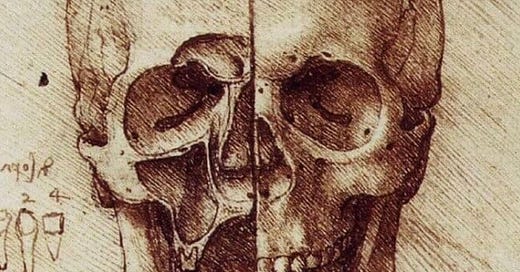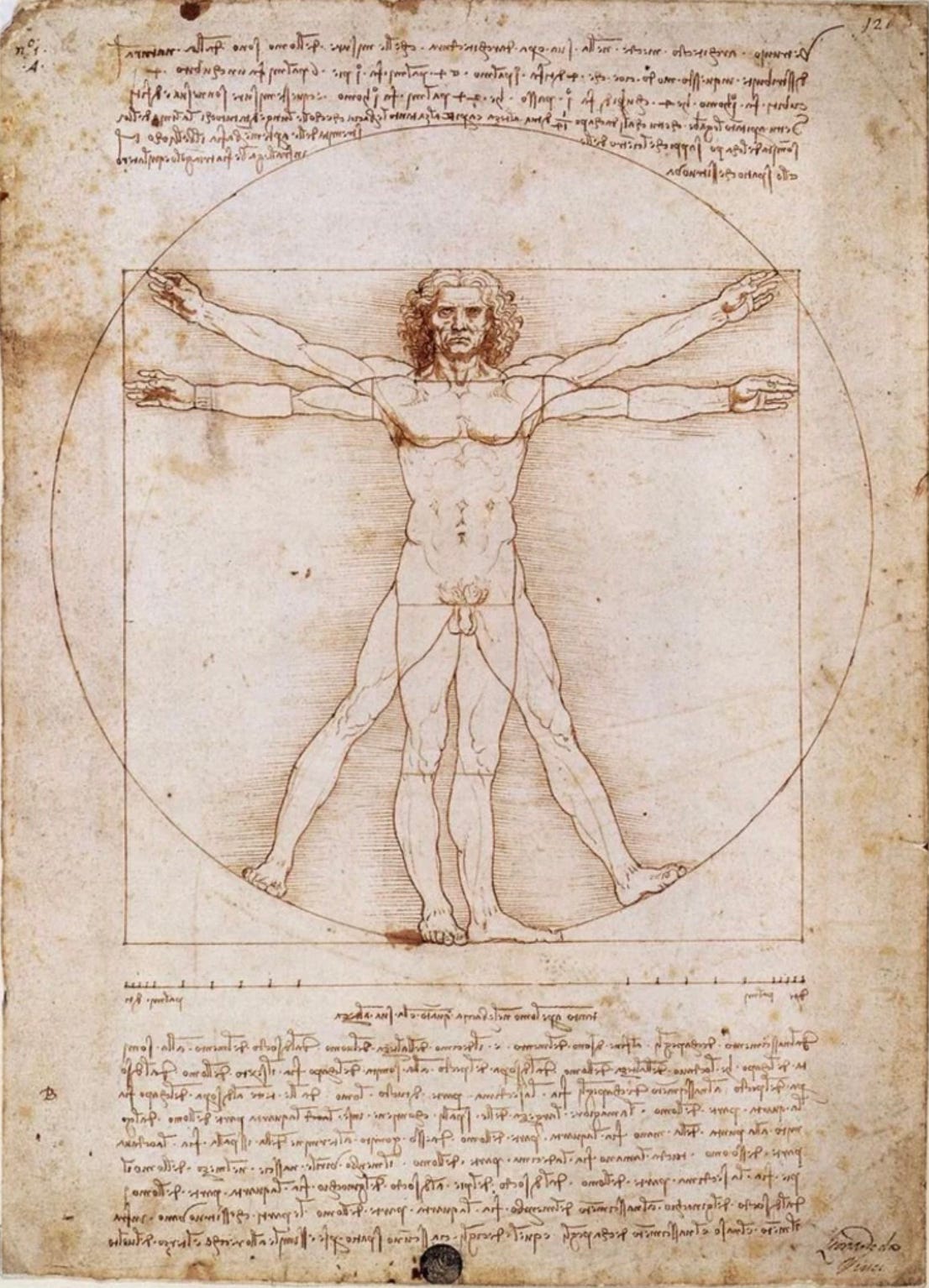It’s fascinating the human will to know with science and research just how bodies operate on molecular and mechanistic levels.
Take for instance the famed Italian polymath, Leonardo da Vinci whose interest in anatomy began with the dissection of various animals — bears, horses, pigs, frogs and oxen. Over candlelight in the crypt of Santa Maria Nuova he was said to have dissected over 30 human bodies of both genders and all ages. Evidence also shows he was vegetarian.1
Proportions of the microcosm
Leonardo viewed his anatomical drawings and The Vitruvian Man as a cosmografia del minor mondo or cosmography of the microcosm. He dedicated much of his art and science to exploring mathematical proportions reflected in the human and animal forms and how they relate to the macrocosm or celestial expressions.
We see this in The Vitruvian Man where the superimposed figure in a square, symbolic of the earthly realm is placed within a circle, symbolizing the spiritual or celestial. His mathematical studies of universal constants emphasizes divine proportions or the golden ratio that is reflective in nature.
He also bought caged birds at the market to set them free.
Vitamine discoveries
Fast forward a few hundred years to the Realism and Post Romanticism eras and we have the discovery of vitamins, originally coined vitamine, derived from the Latin words vita meaning life and amine meaning a compound that contains nitrogen.
The process of discovering the role of essential vitamins was in ‘reality a slow, stepwise progress that included setbacks, contradictions, refutations, and some chicanery’, according to the National Institute of Health.2 Sounds familiar to modern research and science. After all, science is an inspiration of the times.
Sailors between 16th and 18th centuries wouldn’t have fared too well if taken the advice of say one modern doctor who stated recently on a podcast that “all plants are poisonous.”
An estimated two million sailors died between those centuries with horrific symptoms ranging from black blisters, foul ulcers, bleeding gums, loosing teeth and emaciation. Crew physicians were baffled at how many deaths were taking place on board. This disease became known as scurvy and it turns out all they needed to do was eat some fruit.
It was symptoms of malnutrition as with beriberi, rickets, pellagra, and xerophthalmia that launched the medical investigations into major nutritional deficiencies in the early nineteenth century.
Interestingly enough, the NIH’s own website confesses these studies were in operation when the ‘germ theory of disease was dominant and dogma held that only four nutritional factors were essential: proteins, carbohydrates, fats, and minerals.’ Key words being: theory, dogma and were dominant.
Today, the germ theory of disease is still very dominant in the foundations of orthodox western medicine as a theory for understanding infectious disease and theories are designed to be tested over time through the scientific method of experimentation, analyzing data and drawing conclusions.
In other words, you could be da Vinci secretly paying grave robbers to dissect bodies over candlelight in a crypt or a division of the NIH on a $375,800 grant in Tunisia to drug beagles and lock their heads in mesh cages so hungry sand flies could eat them to death. Difference being da Vinci’s subjects were dead. The beagles felt everything.
Leonardo wouldn’t have been down with the beagles and the American people sure weren’t happy it about either. The means is the method or as the Canadian communication theorist Marshall McLuhan said, “the medium is the message.”
When science has a proclivity to test more theories on the sources of disease we may be able to collectively shift towards a polyculture way of gardening with crop rotations, companion planting and cover crops that all contribute to less erosion and more nutrient dense soil that is sustainable.
Or, an understanding of components as related to the whole of existence. Healthier planet, healthier species.
Pharmacodynamics, Pharmacokinetics
Pharmacodynamics and Pharmacokinetics are branches of pharmacology that seek to understand how drugs are assimilated in the body. Pharmacodynamics is the study of what the drug does to the body and Pharmacokinetics is the study of what the body does with the drug.
These studies are essential in understanding how the drug is absorbed through chemical reactions, bioavailability, distribution metabolism and excretion in addition to studying receptor binding, post-receptor effects and chemical interactions.
There are holistic means in these two branches of study that consider how chemical reactions enable the drug to either work or cause detrimental results. The body is a complex web of metabolic interactions and a fascinating network of energy.
Let’s not forget food, herbal remedies and exercise are all drugs.
“All things are poisons, for there is nothing without poisonous qualities. It is only the dose which makes a thing poison,” said Paracelsus, Swiss physician and alchemist.
Of course there are poisonous plants as there are poisoned animals who graze on depleted soil if they even have the opportunity to see sunlight outside the confines of factory-farming.
There are also poisonous petroleum based food colorings, like Red 40 and Yellow 5, found for instance in cereals effecting the way nutrients penetrate cell walls for absorption.
Are we sure it’s the plants not the petroleum, doctor?
Pliability of walls
Now is a reasonable time to make some crucial adjustments in public health with 133 million Americans suffering from at least one chronic disease, such as hypertension, heart disease or arthritis, nearly half the population, and it’s on the incline according to the American Hospital Association.3 Something isn’t adding up and I doubt it’s the broccoli.
When millions of people find healing from chronic conditions with Medical Medium’s celery juice, heavy metal or liver detox protocols that is also science.4 It’s been tested and validated through real life experiences not just a Petri dish with isolated animal tissues.
We run into trouble when influencers (some of which are proclaimed medical doctors, naturopaths and scientists) start telling people plants are poisonous and to just eat meat because this prevents people from getting to the source of what is actually making them sick in the first place.
Establishing a baseline of clarity for people when it comes to health and nutrition is essential so they aren’t so overwhelmed and confused when it comes to diet tribes selling regimes.
The ancestral knowledge is apparent from the sailors who needed to eat an orange to Rachel Carson who in 1962 exposed the hazards of pesticide DDT in her book, Silent Spring.
“In nature nothing exists alone.” — Rachel Carson
Grateful for the text books and nutritional studies for laying a foundation to understand how essential vitamins and minerals play out their functions in the human ecosystem, but the food pyramids are subject to change like nature as more data becomes available and shared.
The discernment of what data to ingest is a key ingredient of our time. Tread steady friends.
The American Journal of Cardiology, Human Dissection and the Science and Art of Leonardo da Vinci by Joseph K. Perloff, MD.
National Library of Medicine, The discovery of the vitamins by Richard D Semba
American Hospital Association, Health for Life, Focus on Wellness
Medical Medium, by Anthony William






